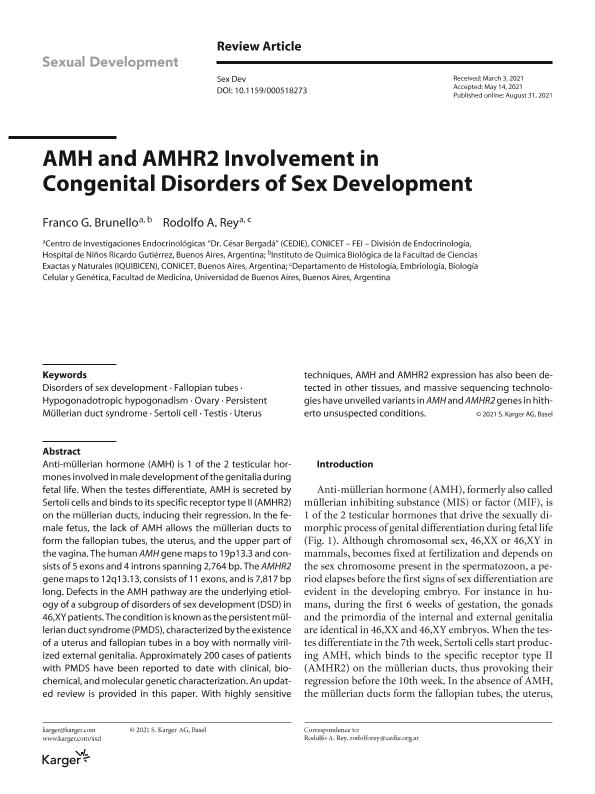Artículo
AMH and AMHR2 Involvement in Congenital Disorders of Sex Development
Fecha de publicación:
08/2021
Editorial:
Karger
Revista:
Sexual Development
ISSN:
1661-5425
Idioma:
Inglés
Tipo de recurso:
Artículo publicado
Clasificación temática:
Resumen
Anti-Müllerian hormone (AMH) is one of the two testicular hormones involved in male development of the genitalia during fetal life. When the testes differentiate, AMH is secreted by Sertoli cells and binds to its specific receptor type II (AMHR2) on the Müllerian ducts, inducing their regression. In the female fetus, the lack of AMH allows the Müllerian ducts to form the Fallopian tubes, the uterus and the upper part of the vagina. The human AMH gene maps on 19p13.3 and consists of 5 exons and 4 introns spanning 2764 bp. The AMHR2 gene maps on 12q13.13, consists of 11 exons and is 7817-bp long. Defects in the AMH pathway are the underlying aetiology of a subgroup of disorders of sex development (DSD) in 46,XY patients. The condition is known as the persistent Müllerian ducts syndrome (PMDS), characterised by the existence of a uterus and Fallopian tubes in a boy with normally virilised external genitalia. Approximately 200 cases of patients with PMDS have been reported to date with clinical, biochemical and molecular genetic characterisation. An updated review is provided in this paper. With highly sensitive techniques AMH and AMHR2 expression has also been detected In other tissues, and massive sequencing technologies have unveiled variants in AMH and AMHR2 genes in hitherto unsuspected conditions.
Palabras clave:
FALLOPIAN TUBES
,
TESTIS
,
OVARY
,
PERSISTENT MULLERIAN DUCT SYNDROME
Archivos asociados
Licencia
Identificadores
Colecciones
Articulos(CEDIE)
Articulos de CENTRO DE INVESTIGACIONES ENDOCRINOLOGICAS "DR. CESAR BERGADA"
Articulos de CENTRO DE INVESTIGACIONES ENDOCRINOLOGICAS "DR. CESAR BERGADA"
Articulos(IQUIBICEN)
Articulos de INSTITUTO DE QUIMICA BIOLOGICA DE LA FACULTAD DE CS. EXACTAS Y NATURALES
Articulos de INSTITUTO DE QUIMICA BIOLOGICA DE LA FACULTAD DE CS. EXACTAS Y NATURALES
Citación
Brunello, Franco Gino; Rey, Rodolfo Alberto; AMH and AMHR2 Involvement in Congenital Disorders of Sex Development; Karger; Sexual Development; 8-2021; 1-9
Compartir
Altmétricas




